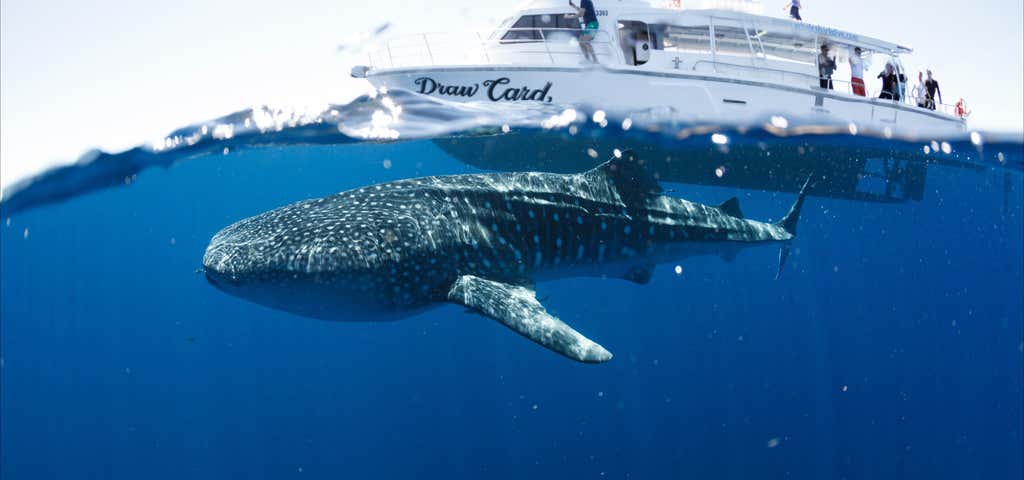Western Australia. The largest state in one of the most ecologically diverse countries on earth boasts some of the most extraordinary wildlife you’ll find anywhere. Whether you hope to experience marine creatures in the ocean or land animals in their natural habitats, Western Australia offers visitors all manner of enchanting encounters.
Of course camels aren’t native to Australia, but when they were brought over during the 1840s to assist with exploration, they fitted in so well, it’s as if they’ve been there forever - and riding one is an experience to treasure. Whether you choose the morning (45minutes), pre-sunset (30 minutes) or sunset tour (one hour), your expedition along Cable Beach on camelback with host Alison Bird is sure to be a treat. As novel as it is educational, Alison is a camel whisperer with over 30 years experience working with these exotic and personable beasts. Rides are suitable for passengers of all ages and it’s just magical.
Ningaloo Reef on the Coral Coast astonishes all who visit. Teeming with marine life, you’ll be dazzled by the white sandy shores and bright turquoise sea hemmed against towering limestone ranges. One of the star attractions involves diving or snorkeling with magnificent whale sharks, resident from March to August. You’ll also want to keep your eyes peeled for manta rays, turtles, dolphins, whales and dugongs who inhabit the waters of this area. And because the focus here is on conservation and education, this aquatic region is truly one of a kind.
Waminda is Aboriginal for peace and tranquillity, and that’s what animals enjoy they settle on this 11 acre farm. On the coast just 10 minutes from Geraldton (five hours north of Perth) visitors can commune with a variety of rescued creatures, among them dingoes, kangaroos, emus, parrots, ducks, geese, chickens, peacocks, horses, snakes, dog, fish and frogs. Feed the animals and pet baby kangaroos or wander about with a parrot on your shoulder. The human inhabitants of this self-sufficient sanctuary make all their own electricity, collect rainwater and try to grow most of their own vegetables and herbs. More than just a safe place for animals, Waminda is an actual way of life, with visitors encouraged to stay a night or two to really get to know the animals. There are a range of accommodation options you can choose from including the chance to sleep outside under the stars. While there is no actual entry fee, please note that owners Ian and Chaliaw rely on donations to keep the sanctuary afloat.
Quokka's of Rottnest Island. Originally called Rats Nest (due to a terrible case of mistaken identity), this isolated island sits 18km west of Fremantle and is categorised as an A-Class Reserve. 25 minutes by fast ferry, the island is popular for day trips as well as longer stays, with visitors spending their time snorkelling, cycling and hiking.
Taking pictures of lighthouses and diving among the many sunken wrecks also brings in the crowds. But surely one of the quirkiest photographs you will take is of the delightful, ever smiling quokka, a friendly marsupial that looks like the love child of a wallaby and a teddy bear. Super cute as they are, please remember they are wild animals so you’re not allowed to feed or pat them, (although these friendly creatures might try to pat you). Also, please be ethical tourists and respect them by taking photographs at a comfortable distance for them.
You will only find the quokka on Rottnest, but the island is also home to sea lions, fur seals and an abundance of birdlife. And if you add in the beach resort aspect of the island, this holiday sanctuary is an absolute must do if you want to meet the curious land and sea based wildlife of Western Australia.
After a 45 minutes drive heading south from Perth, and a 5-minute ferry ride to the island, immerse yourself smack bang in the paradise of the Shoalwater Islands Marine Park. Featuring all manner of protected animals, visitors can spot a variety of seabirds, among them little penguins, pelicans in their rookery, cormorants and ospreys, as well as dolphins and lots of sunbaking sea lions.
Choose between a variety of cruises as Rockingham Wild Encounters offers chances to swim with dolphins, do stand up paddle boarding, snorkelling and kayaking.
To see penguins in the wild, you may have to wait until after sunset as the penguins are out at sea for most of the day searching for food. However, each summer penguins moult and they stay ashore for between 6 and 8 weeks whilst their new feathers grow. Please understand that this is a very stressful time for the little penguins so if you do spot them please leave at least 5 metres between you and the penguins, please be very quiet and relaxed, and please turn your flash off as flash light can damage their eyes. (One thing to remember if you do see a little penguin in the shallow water – please report them to a ranger as this is a sign of heat stress and the rangers will monitor them to ensure they are ok.)
Whilst wild penguins may be a tad illusive, a guaranteed way to see little penguins and to have all of your penguin questions answered is to visit the Discovery Centre at 10.30am, 12.30 and 2.30pm, when the Department of Parks and Wildlife rangers feed the 10 little penguins that live in the centre. (Please note, these little chaps have been injured or orphaned as chicks so they wouldn’t survive if released into the wild.)
90 minutes south of Perth, Bunbury is one of the finest dolphin encounter locations in Australia with bottlenose dolphins visiting throughout the year. The centre itself is home to a discovery pool and aquarium, and you can take guided tours and watch movies about marine wildlife, (some of them in 3D which give the impression of actually being in the water with them). But it’s the sea based tours that really knock people’s socks off. Whether you swim with wild dolphins, take a dolphin boat cruise or get knee deep in the water in the interaction zone and help feed them local fish, this is an excellent opportunity to see these magical creatures in their own environment. The volunteers and staff are dedicated to their ocean work, and will share everything they know as the dolphins go about their daily life.
They also run the Marine Turtle Rescue Project which has a purpose built rescue tank and arranges medical care for any sick or injured turtles that wash up in the region. So you can adopt a turtle whilst you are there and help contribute to the protection of these wonderful yet sadly endangered animals. There is a café and gift shop to round things off and make this an ideal day trip for all ages.
Encountering birds of prey at close quarters is an opportunity not to be missed and at Eagles Heritage, visitors can witness twice-daily sessions where handlers and birds display remarkable skills with pristine bush providing the backdrop.
Set up as a sanctuary for disabled birds to live out their days when injury means they can no longer live in the wild, many of the rescued birds are nursed back to good health and returned to their habitat. But while they’re being rehabilitated some of them become stars of the Eagles Heritage shows.
With hawks, owls and falcons and a variety of raptors, this attraction is as much about conservation and education as it is about entertaining the crowds. Three and a half hours drive from Perth, be sure to make time for the local wineries and pristine beaches.
400km from Perth, the Walpole Wilderness region is about as far-flung as you’re ever likely to get. The tiny towns of Peaceful Bay, Bow Bridge and Nornalup offer diving, fishing and canoe trips as well as the epic 1,000km Bibbulmun Track, which traverses beaches and high coastal ridges, with its riches of flora and fauna. Whilst you may not want to walk it end to end, do try to sample a section of it if you can.
One of the most accessible wonders in this area is the Valley of the Giant Treetops Walk, a forest canopy experience. It’s 600 metres long and takes you 40 metres up into the tingle forest where some of the trees are estimated to be over 400 years old. Walking up among the treetops, you’re up with the birds and although much of the wildlife here is very shy, if you sit patiently you could spot red-winged fairy wrens, as well as a variety or robins, cuckoos and parrots. Frogs, wallabies, possums, and bats are also resident here.
With so much to do, and taking a fair bit of getting to, allow at least four days in this area.
32 km east of Albany this nature reserve is home to all sorts of wildlife including two critically endangered species, the Noisy Scrub Bird and the Gilbert’s Potoroo. With lakes, hills and empty beaches the reserve is also home to other threatened species including the southern brown bandicoot and the western ringtail possum, a range of reptiles, snakes and skinks, and birdlife that features bitterns, parrots, plovers and falcons.
Popular with boaties, the reserve also offers unspoilt areas for hiking and snorkeling. With a modest entry fee at the gate, facilities include a visitors' centre, BBQ area, toilets and a boat ramp. But please note, you do need to bring your own drinking water.
Explore More Trip Guides
Whales, Wonderous Whales. And where to see them Queensland.
- 7 Places
- 25:42
- 1,256 mi
Whales, Wonderous Whales. And where to see them NSW.
- 12 Places
- 18:15
- 926 mi
Queensland And Its Glorious Native Wildlife!
- 12 Places
- 26:35
- 1,344 mi
Tasmania's Wonderful Wildlife
- 10 Places
- 12:56
- 574 mi











